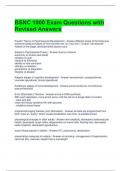BSNC 1000 Exam Questions with
Revised Answers
Freud's Theory of Psychosexual Development - Answer-different areas of the body give
someone pleasure based off how old they are. ex if you are 1-3=anal. can become
fixated on the stage, developmental issues occur
Erikson's Psychosocial Theory - Answer-trust vs mistrust
autonomy vs shame and doubt
initiative vs guilt
industry vs inferiority
identity vs role confusion
intimacy vs isolation
generativity vs stagnation
integrity vs despair
Piaget's stages of cognitive development - Answer-sensorimotor, preoperational,
concrete operational, formal operational
Kohlberg's stages of moral development - Answer-preconventional, conventional,
postconventional
Error (Stochastic) Theories - Answer-errors in DNA synthesis
With each replication, more errors occur until the cell is no longer able to function
- wear and tear
cross-link theory (proteins link with glucose)
- oxidative stress theory
programmed aging theories (non-Stochastic) - Answer-all cells are programmed from
birth, have an "expiry" which causes breakdown over time. Is predetermined.
physiological changes in older adults - Answer-skin elasticity, decreased cardiovascular
health, decreased cough reflex, degeneration of nerve cells, hearing loss, decreased
taste receptors, decreased reproductive
acute illness popular in elderly - Answer-UTI, pneumonia, dehydration
preventative measures for elderly - Answer-no smoking, management of hypertension,
vaccines (flu), exercise, weight loss is overweight
, two forms of hearing loss - Answer-conductive (external and middle ear problems) and
sensorineural (inner ear problems)
Psychosocial changes in older adults - Answer-Retirement
Social isolation (depression)
Sexuality
Housing and environment
Death
normal aging changes - Answer-integumentary (skinn becomes thinner, loses elasticity,
hair thins
respiratory (decreased cough reflex, atrophy of resp. muscles, increased rigidity of
chest wall)
cardiovascular: HPTN, hardenign of arteries, thickening of lumen)
GI (decrease in saliva production)
Lose muscle mass, bones become weaker, decrease vision and hearing, fewer taste
buds, decreased renal blood flow
capacity building - Answer-The process of improving an individual's abilities, skills,
processes, and resources in order to expand, and grow health literacy
5 A's - Answer-Ask
Advise
Assess
Assist
Arrange
components of a perfusion assessment - Answer-client health history, physical exam
(vitals, palpation, ascultation)
diagnostic tests (blood saturation, RBC count)
inspections (skin colour, sweating, heartbeat)
s/s of optimal perfusion - Answer--regular colour
- warm skin
-normal vitals
-normal urine output (.30 ml/hr)
s/s impaired perfusion - Answer--pale
-clammy cold skin
high or low vitals
- weak pulse
- SOB
- cyanosis
decreased urine output




